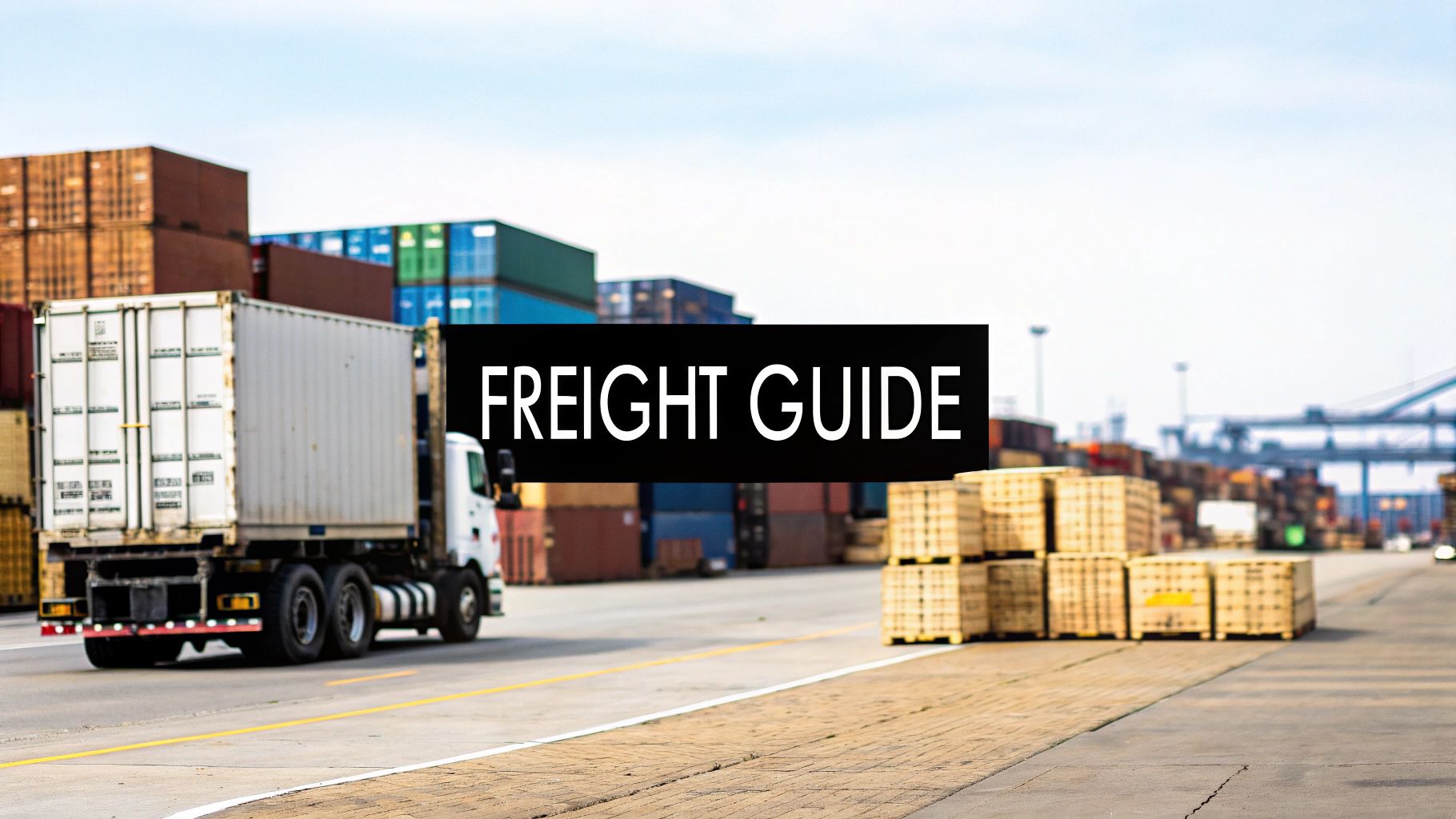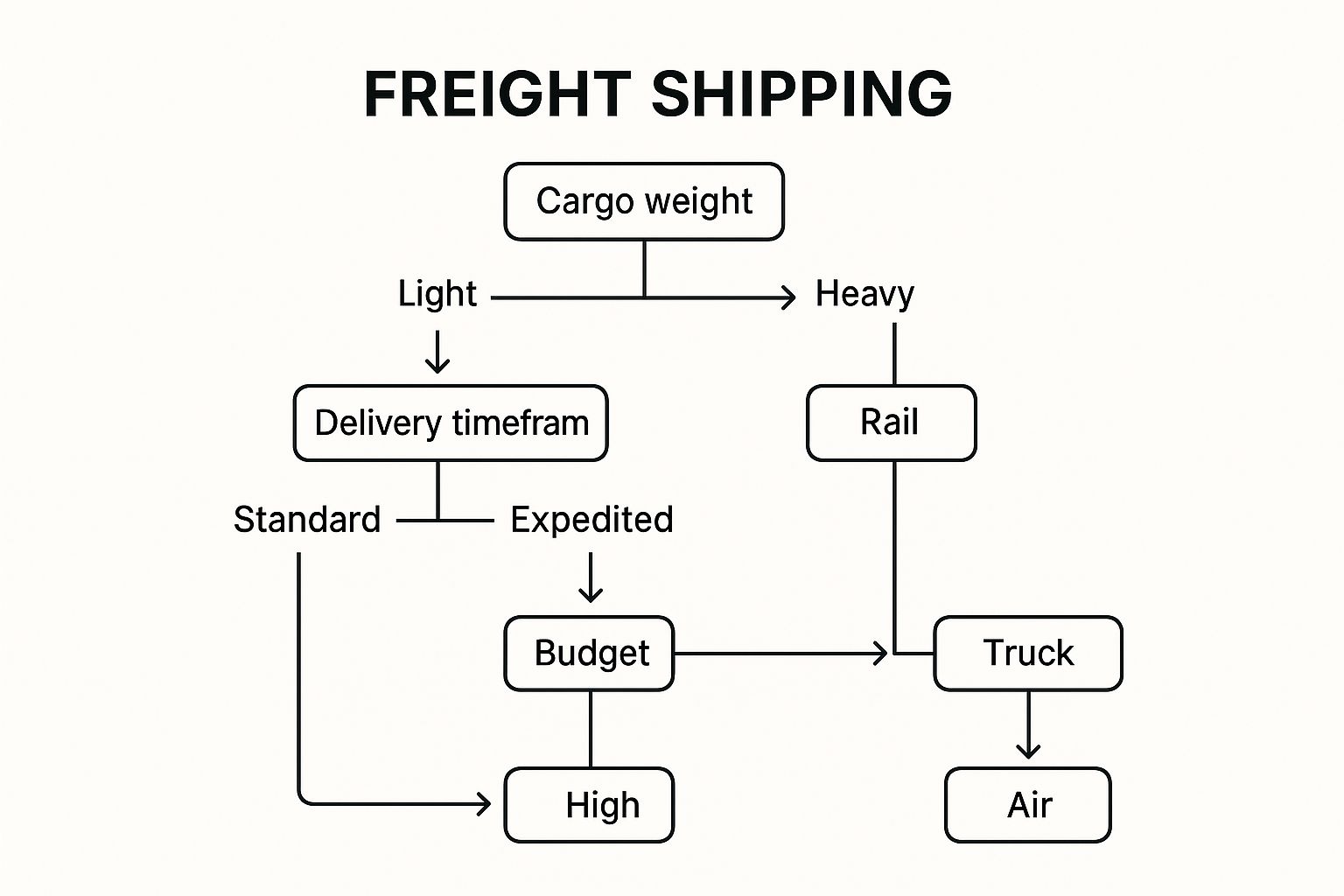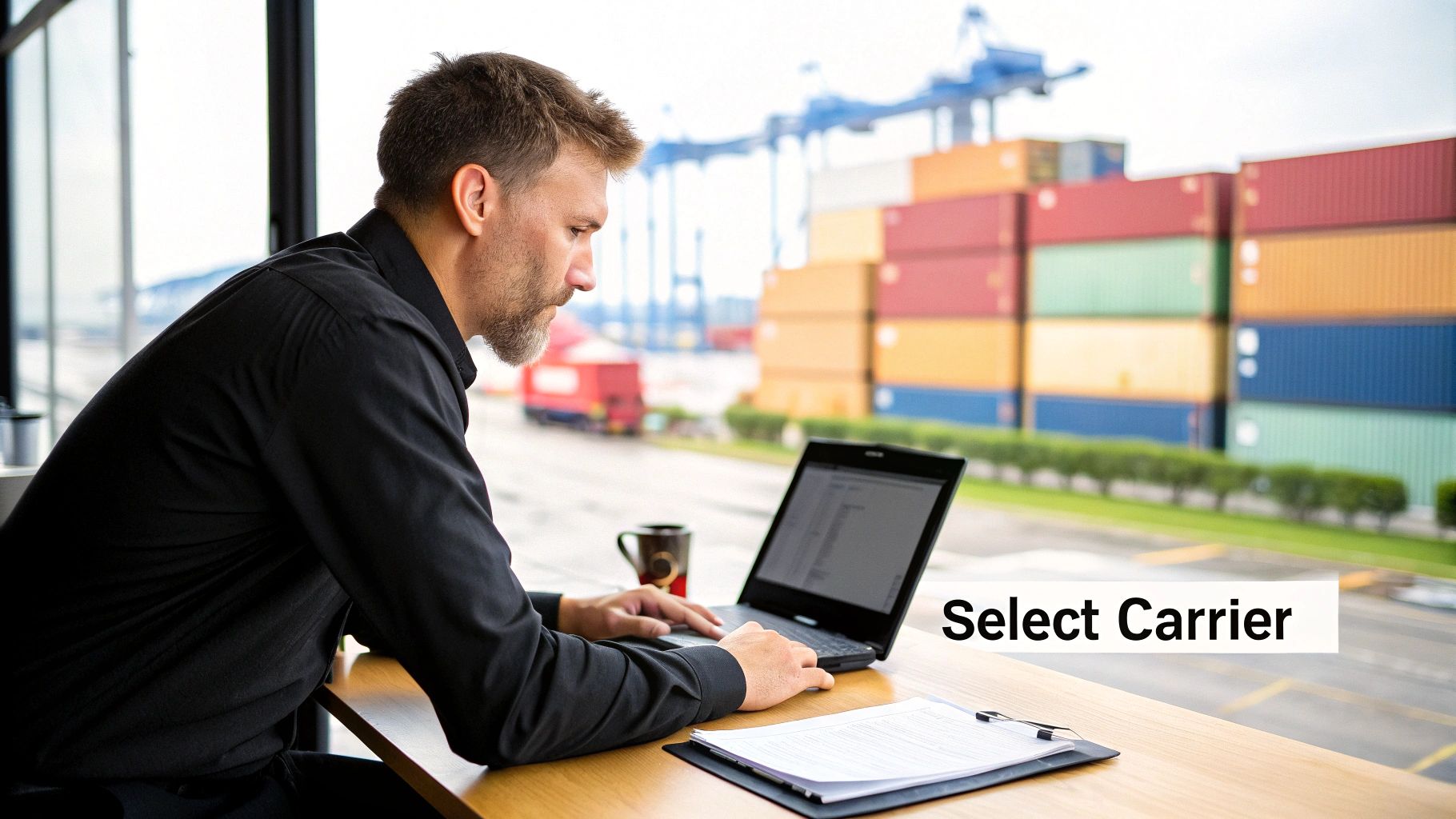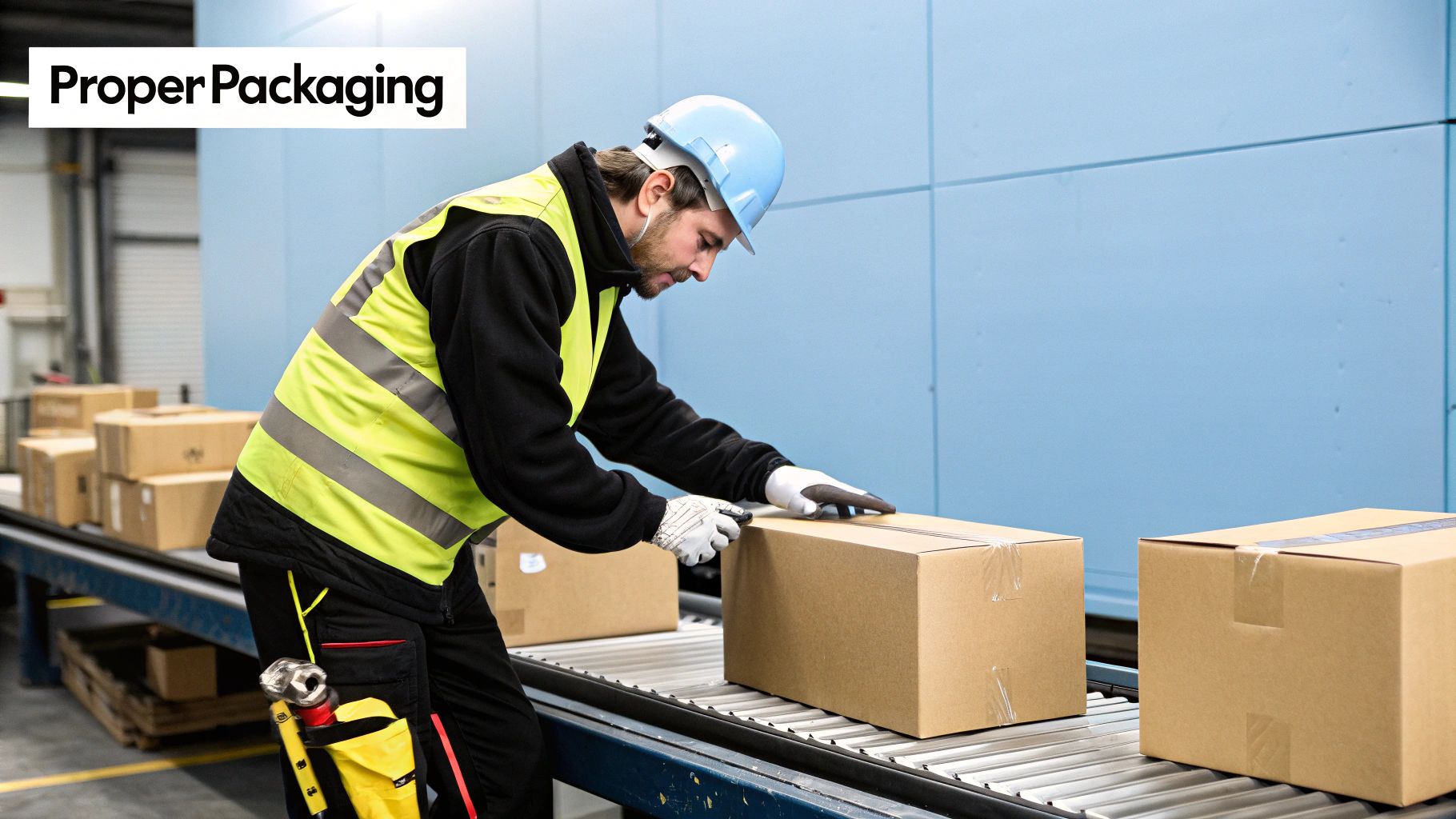Learn how to ship freight with our practical guide. We cover everything from quotes and carriers to packaging and tracking for a seamless shipping experience.

Diving into freight shipping can feel like a huge task, but I've found it really just comes down to getting a few key things right at the start. It's a four-part process: nail down your shipment details, shop for quotes, get your paperwork and packaging in order, and then schedule the pickup.
Honestly, the most critical part is that first one—knowing exactly what you're shipping. Every other step, from cost to carrier choice, hinges on getting those initial details right.
Before you can even think about finding a carrier or getting a price, you need to become an expert on your own freight. I can't stress this enough. Every single detail—weight, dimensions, even its shape—directly impacts your final bill, the kind of truck you'll need, and whether things go smoothly or end in a headache.
Getting this wrong is the number one reason I see people get hit with surprise fees and frustrating delays. It's like building a house; you wouldn't just start ordering lumber without a solid blueprint. In the world of freight, your shipment's specs are that blueprint.
This is where you need to be precise. "Close enough" won't cut it. Carriers have systems in place, like re-weigh and re-measure stations at their terminals, to double-check the details you provide on the Bill of Lading (BOL). If your numbers don't match theirs, you're looking at a re-weigh or re-classification fee, and those can sting.
Make sure you measure the total dimensions of your freight only after it's completely packaged, wrapped, and sitting on the pallet. Get the length, width, and height in inches at their absolute widest points. Then, get the total weight in pounds.
My Two Cents: Never, ever guess or just use the weight listed on the manufacturer's box. You have to weigh the final, ready-to-ship unit. Remember, the pallet itself adds 25-50 pounds, and all that shrink wrap and cardboard adds up, too. A standard bathroom scale might work for a small box, but for a full pallet, you really need a pallet jack with a built-in scale or a proper commercial freight scale to be accurate.
If you're shipping via Less-Than-Truckload (LTL), you'll also need to figure out your freight class. This is a standardized numbering system, ranging from 50 to 500, that all carriers use to categorize different types of goods.
Think of it this way: a low class (like 50) is for things that are dense, sturdy, and easy to stack, making them cheap to ship. A high class (like 500) is for items that are super light for their size (low density) or very fragile, making them more expensive and difficult to handle.
This classification boils down to four main things:
Getting the freight class wrong is an incredibly common—and costly—mistake. If you have any doubt, use an online freight class calculator or talk to a freight professional. A few minutes of checking can save you hundreds in unexpected charges down the road.
Ready to see how all these details come together to create your shipping rate?
Okay, with your details in hand, it's time for your first big decision: are you shipping Full Truckload (FTL) or Less-Than-Truckload (LTL)? Your choice really comes down to the size of your shipment and what your priorities are—cost, speed, or safety.
This handy visual breaks down how factors like weight and urgency can point you toward the best shipping method.

As you can see, heavier shipments almost always go FTL. But if you have a lighter load and aren't in a huge rush, LTL is where you can find significant savings.
Let's dig a bit deeper into what separates these two options.
Choosing between LTL and FTL is a fundamental step that sets the tone for your entire shipment. Here's a table to help you compare them side-by-side.
At the end of the day, LTL is the go-to, budget-friendly choice for smaller shipments that aren't on a tight deadline. On the flip side, FTL gives you speed and security for larger loads or high-value goods, since it cuts out all the extra handling and goes directly to its destination.
Making the right choice here is half the battle won.

So, you’ve gathered all your shipment’s details and you’re ready to get some quotes. Getting a price is the easy part. The real skill is knowing how to read between the lines. A freight quote isn't just a number; it’s a detailed story about your shipment's journey and a snapshot of the current market.
Think of it like an itemized receipt for a big purchase. You wouldn't just glance at the total and pay up, would you? You’d want to see what each charge is for. Learning to dissect a quote this way is your best defense against surprise fees and helps you budget with confidence. It also empowers you to ask the right questions before you commit to a carrier.
At first glance, a quote can look like a jumble of industry jargon and numbers. But once you break it down, you'll find most quotes are built on three core components. Understanding these is key to knowing exactly where your money is going.
Base Rate: This is the fundamental cost of moving your freight from its origin to its destination. It's the carrier's price for the basic transportation service, influenced by factors like weight, distance, and freight class. Every carrier sets its own base rates, which is why you’ll see differences when you compare options.
Fuel Surcharge: This is the unavoidable fee that covers the ever-changing cost of diesel. It’s usually calculated as a percentage of the base rate and is adjusted weekly based on national averages published by the Department of Energy. You can't control this one, but you should always expect it on your bill.
Accessorial Fees: Think of these as "à la carte" charges for any service beyond standard, dock-to-dock shipping. If the delivery location doesn't have a loading dock and you need a truck with a liftgate, that’s an accessorial fee. Other common examples include residential delivery, inside delivery, or calling ahead to schedule the delivery appointment.
Here’s a classic rookie mistake: assuming a quote includes everything you need. One of the most common reasons for a post-shipment billing adjustment is an unplanned accessorial fee. Always double-check if services like a liftgate or residential delivery are already built into your price.
Ready to see a transparent, itemized breakdown for your shipment? You can get a clear picture of your costs in just a few minutes.
Beyond the three main components, a handful of dynamic factors push your final price up or down. These are the "why" behind your quote, explaining why the rate you get today might be different from the one you get tomorrow.
Key Rate Influencers:
Getting a feel for these market dynamics is what separates savvy shippers from the rest. For example, if you know the market is tight, you’ll want to book your shipments further in advance to lock in a better rate. A great freight partner can give you this kind of insight. If you're new to working with shipping experts, our guide explaining the definition of a freight broker is a great place to start.
It’s also smart to keep an eye on the bigger picture, as global trends can have a surprising impact on your domestic shipping costs. For instance, the ocean freight market is often a leading indicator of global trade health. Projections show that the global ocean freight market is expected to grow by 3.0% to 4.0% in container volumes during 2025.
This growth, primarily fueled by manufacturing in the Asia-Pacific region, is causing shifts in carrier alliances and demand patterns. These changes ripple through the entire logistics network, affecting truck availability and pricing right here at home. Businesses that adapt by building strategic carrier relationships could potentially cut their freight costs by up to 15%. Keeping up with these trends gives you a serious competitive edge.

When you’ve got a handful of quotes, it’s so tempting to just grab the cheapest one and move on. But trust me, in the world of freight, the "cheapest" option can easily become the most expensive one if it means delays, damaged goods, or—worst of all—unhappy customers.
Choosing the right carrier is less about finding a low-cost vendor and more about finding a true partner. It’s about looking beyond the dollar signs to see who you can count on. A good choice means your freight gets where it needs to go safely, on schedule, and with the care it deserves.
That initial quote? It’s just one part of the story. A carrier that's 10% cheaper but only shows up on time 80% of the time will cost you a fortune in the long run. I’ve seen it happen. Real value is found in the sweet spot between cost, reliability, and service.
Here’s what you should actually be digging into:
The carrier's geographic reach is a huge factor. Each type—national, regional, and local—has its strengths, and knowing when to use each is a game-changer for optimizing your shipping strategy.
For instance, shipping from a warehouse in Los Angeles to a customer in Las Vegas? A regional carrier specializing in the Southwest will almost always be faster and more cost-effective than a national one.
And if you’re moving goods across the border, that requires a whole other level of expertise. For shipments heading north, our guide on using a freight forwarder to Canada is a great resource.
Not every shipment is a five-alarm fire. Carriers offer different service levels, so you can find the right balance between speed and budget. Choosing wisely means you won’t overpay for speed you don’t need or miss a critical deadline by being too frugal.
My Two Cents: The goal here is simple alignment. Don't pay for expedited service on a routine inventory restock—that's just burning cash. But don't risk a time-sensitive delivery with standard service, either. That’s just asking for trouble.
Here’s a quick rundown of what you’ll typically see:
Keep in mind that the global freight market always has a say in service and costs. The 2025 freight landscape is shaping up to be a period of correction, influenced by tariff uncertainties and how carriers manage their capacity. For example, recent issues in the Red Sea have kept Asia-Europe ocean rates high, but now carriers are planning to blank more sailings to manage capacity, which could affect rates. On the other hand, air freight from China to Europe has seen rates drop 12% in a month because there's more space than demand. Understanding how global freight trends could impact your costs will help you make smarter decisions.
Once you’ve chosen your carrier, it's time to roll up your sleeves and focus on the two most hands-on parts of the job: getting your freight physically ready and nailing the paperwork. Honestly, getting these two things right is your best insurance policy against damage, delays, and surprise fees. It’s all about setting your shipment up for a smooth ride before it even leaves your dock.
Think of it this way: proper packing protects your goods from the reality of transit, and accurate paperwork is its passport, telling the carrier everything it needs to know. Cutting corners on either one is a fast track to a costly headache.
For most LTL freight loads, the gold standard for preparation is palletizing. A solid, well-packed pallet is stable, easy for forklifts to manage, and your best defense against the bumps and shuffles that happen on the road. If you ship regularly, this is a skill you absolutely need to have down.
Here’s what I’ve learned about building a rock-solid pallet:
A rookie mistake I see all the time is not wrapping the shipment to the pallet itself. People wrap the boxes together, but if the truck stops short, the whole load can slide right off the base. You have to make sure that shrink wrap is locking the freight directly to the wood.
With your pallet packed and ready, it's time for the most important document in the whole process: the Bill of Lading (BOL). This isn't just a shipping label. It’s a legally binding contract between you (the shipper) and your carrier. It has every critical detail about your shipment and acts as both a receipt and a title for your goods.
I can't stress this enough: your BOL has to be 100% accurate. A wrong weight, a wrong freight class, or a typo in the address can cause a cascade of problems. You could be looking at re-weigh fees, delivery delays, or serious headaches if you need to file a claim. Precision is everything here.
To fill out a BOL correctly, you'll need this information handy:
Never, ever rush through the BOL. Read it over twice before you hand it to the driver. This single piece of paper is the key to a predictable, drama-free shipping experience.
Alright, you've done the hard work—your pallet is packed, the paperwork is sorted, and you’ve picked your carrier. Now comes the moment of truth: the handoff. Getting pickup day right and knowing how to track your freight are the final pieces of the puzzle for a smooth delivery.
Think of it like the last leg of a relay race. You've set everything up perfectly, but that final, clean handoff to the driver is what gets you across the finish line without a hitch.
When pickup day rolls around, you’ll want to have your shipment ready and waiting in a spot that’s super easy for the driver to get to, like right by your loading dock or main pickup area. Drivers are on a tight schedule, so having everything staged and ready to go can prevent delays or even a missed pickup.
When the truck pulls up, the driver is looking for two things: your freight and the Bill of Lading (BOL).
Work with the driver to get your freight loaded safely. If you paid for a liftgate, double-check that the truck has one. If you're loading from a dock, make sure the path is completely clear. A little bit of cooperation goes a long way with the folks handling your valuable goods.
Expert Tip: Before that truck even thinks about pulling away, get the driver’s signature and the PRO number. The driver will usually slap a sticker with this number onto your BOL. This PRO number is the magic key you'll need to track your shipment’s every move online.
Once your shipment is on the road, that PRO number from your BOL is your new best friend. Just pop that number into the carrier’s website, and you’ll get a near real-time look at its journey from your dock to its destination.
The tracking updates can sometimes seem a bit cryptic, but they usually follow a pretty clear path:
Don't panic if you see a status like "At Terminal" for a little while. This is totally normal—it's just waiting to get loaded onto the next truck for the next leg of its trip. But if you see it stuck there for more than a day or two without an update, it's probably a good idea to give the carrier or your freight broker a call to see what’s up.
Just because your shipment has arrived doesn't mean the job is done. The consignee (that’s the person receiving the goods) needs to give the freight a thorough inspection for any damage before signing the delivery receipt. This is the absolute last chance to flag any problems.
If you spot anything that looks off—crushed boxes, torn shrink wrap, or pallets that look like they've been in a fight—note it down on the delivery receipt in detail. Don't just write "box damaged." Be specific: "Forklift puncture on north-facing side of Box 3." Snap a few pictures with your phone right then and there.
What if you find damage after the driver has already left? You can still file what's called a concealed damage claim, but it's a much tougher battle to prove the carrier was at fault. You typically have only 5 days to report concealed damage, which is why a careful inspection on arrival is so important.
This final check holds everyone accountable and protects you if the worst happens. It also helps to be aware of what's happening in the bigger shipping world. For instance, global issues can create unexpected bottlenecks. We've seen container congestion on the West Coast of the United States cause delays of around ten days per container due to supply chain rerouting. These larger pressures, along with geopolitical events, can trickle down and throw a wrench in schedules and costs. You can learn more about how the global freight market is shifting on FitchRatings.com.
Ready to plan your next shipment with confidence?

Even after you’ve got a few shipments under your belt, freight can still feel a bit mysterious. It’s totally normal to have nagging questions about confusing terms or what to do in unexpected situations. A little know-how goes a long way in building confidence.
I’ve pulled together some of the most common questions we get from shippers just like you. Let's break them down with clear, straightforward answers so you can get back to what you do best—running your business.
Getting the freight class correct is hands-down one of the most critical parts of any Less-Than-Truckload (LTL) shipment. Why? Because that number is a huge factor in how carriers calculate your rate. Get it wrong, and you're looking at a costly reclassification fee later on.
It all boils down to four things: density, stowability, handling, and liability. To find your class, you'd ideally start by finding the National Motor Freight Classification (NMFC) number for your specific product. But if you don't have that handy, the most important factor is your shipment's density.
Here's a quick rundown on how to calculate it:
This PCF value lines up with one of the 18 freight classes, which range from class 50 (low-cost, dense items) all the way up to class 500 (high-cost, very light items). A freight class calculator can simplify this, but if you’re ever unsure, it’s always best to ask an expert.
Have questions about your freight class? We can help you figure it out.
In freight shipping, you often learn by making mistakes—but it’s a lot less painful to learn from someone else's! From my experience, the costliest errors almost always fall into three buckets: inaccurate details, bad packaging, and messy paperwork.
Giving the wrong weight or dimensions is the absolute number one cause of surprise charges. Trust me, carriers verify everything at their terminals. If your numbers are off, a re-weigh fee is pretty much a guarantee. Likewise, poor packaging—like using a cracked pallet or not shrink-wrapping your goods securely—is just asking for trouble and can get your damage claim denied.
Your Bill of Lading (BOL) isn't just a piece of paper; it's your contract with the carrier. Forgetting to check the "liftgate required" box or putting an incomplete address on it will bring your shipment to a screeching halt. Always double-check your measurements, use quality packaging, and treat your BOL like the critical document it is.
This is a big one, and misunderstanding it can be a costly lesson. Let's be crystal clear: Carrier Liability is not insurance. It's simply the carrier's minimum legal responsibility if they lose or damage your shipment, and the payout is often shockingly low.
The amount you'd get back is based on your freight class and the carrier's specific rules, which could be as little as a few cents per pound, no matter what your stuff is actually worth. On top of that, you have to prove the carrier was directly at fault for the damage to get a dime.
Freight Insurance, on the other hand, is a separate policy you buy to protect the full value of your goods. It covers loss or damage in transit, often regardless of who was at fault. While it adds a small cost upfront, it provides genuine financial protection and, just as importantly, peace of mind. If your shipment is valuable, fragile, or time-sensitive, freight insurance is always a smart move.